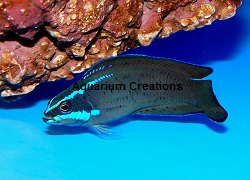Springeri Dottyback, Captive Bred
Pseudochromis Springeri

Identification:
Another beautiful dottyback from the Red Sea, Springer's Dottyback is an excellent addition to the reef aquarium. Its coloration is black with blue lines running through the head region. Springer's Dottyback is a very active, graceful swimmer, and is a joy to watch working their way around the rocky reef. ORA is the largest marine ornamental hatchery in North America and they are constantly developing new techniques to bring the finest captive bred specimens to environmentally conscientious aquarists throughout the world. Aquacultured marine life is the only alternative to wild caught marine aquarium fish.The tank bred Springer's Dottyback is quite easy to keep and feed and will make a great fish for both the beginner or the advanced saltwater aquarist. An excellent additional benefit to the Tank Raised Springer's Dottyback is that they prey on reef aquarium pests such as bristleworms but will not bother other reefsafe tank mates!
Tank Recommendations:
Dottybacks require an aquarium of at least 30 gallons and with a rock-associated lifestyle should be provided with plenty of live rock and hiding places. They are middle to bottom dwellers that generally mix well with other reef inhabitants, but are territorial and can become aggressive towards other Dottybacks or similar-shaped fish.
Food and diet:
Dottybacks are carnivorous and naturally prey upon small shrimp, amphipods, copepods and bristleworms. In the aquarium they should be fed a variety of meaty foods such as live, frozen, freeze-dried, and vitamin enriched brine shrimp, finely chopped mysis shrimp, finely chopped krill and other sea foods; as well as carnivore/omnivore pellets and flake foods. To preserve the stunning coloration of a Dottyback, variety and vitamins are very important (their beautiful color may fade without them). Feed 1 to 2 times per day.
Level of Care:
Easy
Acclimaton Time:
2+ hours
Reef Compatibility:
Excellent
Approximate Purchase Size:
1-1/4" to 2"
|
|

